
- Home Page
- Accepted
Paintings & Copies - Doubtful
Attributions - Doubtful Textual References
- Alternative
Titles - Collectors &
Museums - Bibliography
- Search Abecedario
- Watteau &
His Circle
L’Avanturière (copy 1)
Entered December 2015; revised April 2021
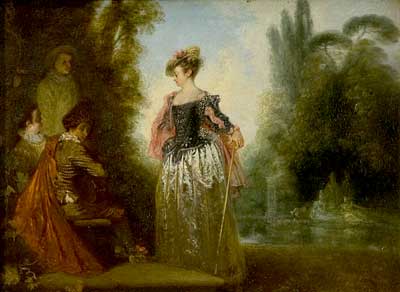
Brodick Castle, Scotland
Oil on copper
17.7 x 26 cm
ALTERNATIVE TITLES
The Adventuress
Fête champêtre
Garden Scene with Figures in Conversation
Garden Scene
RELATED PRINTS
The painting was lithographed by Alexandre IV Moitte and included in Monuments des arts du dessin . . . recueilis par le Bon Vivant Denon (Paris: 1829), 4: pl. 300.
PROVENANCE
Paris, collection of Charles François Silvestre (1667-1738; painter). By descent to his grandson, Jacques Augustin de Silvestre.
Paris, collection of Jacques-Augustin de Silvestre (1719-1809). His sale, Paris, February 28ff, 1811, lot 79: “WATTEAU (Antoine) . . . Deux Tableaux, Dans l'un, une jeune Dame debout écoute un cavalier qui pince de la guitare; un homme habillé en pierrot et une jeune fille sont assis près de lui. Dans l'autre, un Homme pinçant de la guitare près de deux dames assises et d'un homme habillé en mezzetin. Des bosquets terminent les fonds de ces compositions. / H.6.p.10l., L.9p.6l. C / Un dessin fin et correct, une couleur vigourese et transparent, et une touche spirituelle, sont les qualités qu'on admire dans ces deux ouvrages de Watteau.” According to an annotated copy of the catalogue in the London National Gallery, it was bought for 440 francs by a “Mr. L.” The Getty Provenance Index identifies the buyer as Lavallée fils.
Baron Denon Dominique Vivant, (1747-1825; Directeur Général des Musées Impériaux). His sale, Paris, May 1-9, 1826, lot 188: “Deux tableaux d’un pinceau trés fin. Ils représentent des réunions de cavaliers et de dames dans des jardins; ils sont en habits de carnaval. Dans l’un, deux jeunes dames viennent de quitter leur domino, elles se sont assises près des corbeilles de fleurs; un des cavaliers joue de la guitare. Dans l’autre, une jeune femme, déguisée en bergère galante, est debout près de trois personnes aussi en habits de caractère et groupées dans la demi-teinte; une d’elles joue de la guitare. Des ifs, des jets d’eau, des allées d’arbres et des bosquets, donnent l’idée des jardins les plus agréables et accompagnent parfaitement les figures. L’un est lithographié. / L. 10 pouces. — H. 7 pouces. C.” The two pictures were purchased by Gregorio Franchi for 3015 francs.
Paris, collection of Simon Jacques Rochard (1788-1892; miniature painter), about 1830.
Bath, collection of William Thomas Beckford (1760-1844). His ownership is attested to by an 1844 inventory: “Inventory and Valuation . . . of Nos 10 and 20 Lansdown Crescent Bath,” Oxford, Bodleian Library, MS. Beckford c. 58, p. 12: “A Pair – Garden Scenes with Figures in Conversation” by “Watteau.” His sale, Bath, July 24ff, 1848 (third day), lot 33: “Watteau / A Pair – Garden Scenes, with Conversation and Musical Parties. Two precious and valuable Specimens of the Master, richly coloured, and very highly finished. Copper, 7 ½ inches by 10 ¼ inches.” The pictures were apparently bought in or withdrawn.
Easton Park, collection of William Beckford, Duke of Hamilton. They are cited in “List of Pictures, Furniture, Ornaments, China & c. sent from Bath to Easton Park,” 1848-1849, Easton Park (Suffolk), NRAS 332/M/12/50, 2: “Sent to Easton Novr 1849 / A Pair – Garden Scenes / Watteau.” Also cited in “A True and Perfect Inventory and Appraisement of All and Singular the Household Furniture, Plate, Linen, China, Books, Prints, Pictures, . . . the Personal Effects of The Most Noble His Grace The Duke of Hamilton K.G. at the Mansion at Easton . . . who died on the 18th day of August 1852. Taken and made on the 13th and following days of September,” Easton Park (Suffolk), NRAS 332/M/12/52, 2: 17-18: “Garden Scene / Watteau.”
Collection of Susan Euphemia Beckford, Duchess of Hamilton (d. 1859; wife of Alexander, 10th Duke of Hamilton). By descent to her grandson William, 12th Duke of Hamilton (d. 1895). Under the terms of a trust fixed in 1893, the paintings passed to his daughter, Mary Louise Douglas-Hamilton, later Duchess of Montrose.
EXHIBITIONS
London, Royal Academy, Landscape in French Art (1949), cat. 88 (by Watteau, The Adventuress, lent by the Trustees of the twelfth Duke of Hamilton).
Manchester, Art Treasures Centenary (1957), cat. 172 (by Watteau, The Adventuress, lent by The Duke of Hamilton’s Trust: Arran and Easton Trustees).
Washington, Paris, Berlin, Watteau 1684-1721 (1984), cat. 20 (by Watteau, The Adventuress [L’Aventurière], lent by Brodick Castle, National Trust of Scotland).
New York, Metropolitan Museum, Watteau, Music, and Theater (2009), cat. 6 (by Watteau, The Adventuress [L’Avanturière], lent by Brodick Castle, National Trust for Scotland).
SELECT BIBLIOGRAPHY
Amaury-Duval, Monuments des arts du dessin (1829), 4: n.p.
Goncourt, Watteau (1875), cat. 109.
Dacier, Vuaflart, and Hérold, Jullienne et les graveurs de Watteau (1921-29), 1: 199, 3: cat. 11, p. 137.
Réau, Watteau (1928), under cat. 103.
Adhémar, Watteau (1950), 146 note 8, under cat. 124.
Watson, “Watteau, Peintre Inconnu” (1962), 126.
Aix, La Passion selon Don Juan (1991), under cat. 121-22.
Rosenberg and Prat, Watteau, catalogue raisonné des dessins (1996), cat. 484, 609.
Temperini, Watteau (2002), cat. 27.
Brussels, Palais des beaux-arts, Watteau, Leçon de musique (2013), under cat. 39.
RELATED DRAWINGS
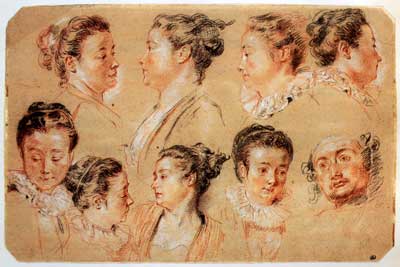
Watteau, Studies of a Woman’s Head and a Man’s, red, black and white chalk, 25.1 x 38 cm. Paris, Musée du Louvre, Département des arts graphiques.

Unidentified artist, L’Avanturière (detail), Brodick Castle.
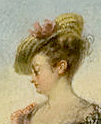
Unidentified artist, L’Avanturière (detail), Brodick Castle.
Normally, one does not need to speak of drawings related to copies of Watteau’s compositions, since the copies are based on the painting or a print after the composition. In this instance, curiously, the copyist has relied on a Watteau drawing now in the Louvre (Rosenberg and Prat 484). Grasselli, Rosenberg, and Prat have pointed out that the head of the seated woman in the Brodick Castle painting was based upon the head of the woman in the bottom row, second from the left. Also, the head of the adventuress was based on the study second from the left in the top row of the drawing. While the close relationship between the painting and drawing would be normal if the copyist were Watteau, we do not believe this is the case here. This problem is discussed below in greater detail.
REMARKS
This version of L’Avanturière and its pendant L’Enchanteur were rarely cited in the Watteau literature of the late nineteenth and early twentieth centuries. Although they were thought to be by Watteau by the Hamilton family and were listed under his name in their various inventories and evaluations drawn up during those decades, Watteau scholars did not know the paintings firsthand. At best they were remembered through the Sylvestre and Denon catalogues, but were viewed as copies. Dacier, Vuaflart, and Hérold, as well as Réau, classified them as copies without having seen them and without knowing where they were. When the pair of paintings was presented at the 1949 Royal Academy of Art exhibition, they were shown together with the Troyes pictures and were presented as “attributed to” Watteau. A decade later, F. J. B. Watson pointedly wrote against them, saying that they showed “how very deceptive the best contemporary copies can be.” A turning point occurred in 1984, when the pictures were again shown in tandem with the originals from Troyes and, this time, Pierre Rosenberg presented them as autograph works. Since then the Hamilton paintings have been accepted by a number of scholars, including Bruno Ely and Catherine Camboulives in the 1991 exhibition at Aix, by Temperini in 2011, and by Florence Raymond in 2013.
Yet one should question whether this optimism is wholly justified. Rosenberg was very much swayed by the account given by Vivant Denon, and recorded in Amaury-Duval's Monuments des arts du dessin. According to Denon, Watteau had given the paintings to Charles François Sylvestre as a token of their friendship. Denon wrote, "I have a painting by him [Watteau] whose figures were drawn from his friends the Italian actors. The color of this painting is admirable; it was done as a token of friendship for his friend, Silvestre, engraver and drawing master of the Royal children: I bought it at the sale of the grandson, with its pendant, which is equally precious.” However, this account, written a century after the supposed gift was tendered is garbled at best. There was some relationship between Watteau and the Silvestre family, and Watteau based his painting La Chute d’eau on a drawing made by one of them. Something of this may lie behind the legend that Watteau gave these pendants to Charles François Silvestre.
Insufficient attention has been paid to the many changes introduced in the Brodick Castle picture. In general, the artist altered details that mitigate the stiff, awkward quality of the Troyes version and aligned it more closely with Watteau’s mature style. Although the adventuress is posed in profile, her posture is not the severe type seen in early works such as the Troyes painting or L’Hiver in the Musée Carnavalet. Most interesting, Grasselli, Rosenberg, and Prat point out that the female heads in this copy are based on a Watteau drawing now in the Louvre. Nonetheless, these studies from the model are subtle and nuanced, but the same cannot be said of the heads in the Brodick Castle painting.
The costumes in the Scottish version have been modified as well. In place of the Troyes adventuress’ distinctive hat with its pert cockade (a type of accessory that Watteau favored in his early career, as in Les Jaloux), the painter of the Brodick Castle picture chose a type of straw hat that Watteau used in his later career (but only occasionally for women, as in the pilgrim alighting into the boat in the Berlin Embarquement). Even less typical of Watteau, the adventuress has a white silk skirt that glistens with undue brilliance, and she wears a small pink cape whose color is almost without parallel in Watteau’s oeuvre for a principal figure (an exception would be one of the pilgrims boarding the boat in the Île de Cythère). Most damning of all, her vest has been adorned with a design of dots and large flowers. Except for the dress worn by the girl in Iris, c’est de bonne heure, Watteau consistently eschewed all patterned fabrics other than those with simple stripes.
The many qualitative differences and the oddities of costume in the Brodick Castle painting should make one wary of accepting the picture as authentic. Similar issues arise in the pendant L’Enchanteur. It seems inescapable that the two paintings are slighter later copies with significant variations. But, at the same time, the copyist's dependence on the Watteau drawing of heads in the Louvre suggests that he was within Watteau’s circle. Who was the copyist? What were the circumstances behind the painting’s creation? These are intriguing but unresolved issues.
L’Avanturière (copy 2)
Entered November 2015

Whereabouts unknown
Materials unknown
Measurements unknown
PROVENANCE
Paris, January 30-February 1, 1851, Anonymous sale, lot 51: “WATTEAU . . . La conversation entre une dame debout en costume d’amazone et un homme assis, jouant de la mandoline. Composition gravée.”
Paris, April 14-15, 1851, lot 103: “WATTEAU . . . L’Aventurière. Ce Tableau est gravé.”
SELECT BIBLIOGRAPHY
Hédouin, Mosaique (1856), cat. 21.
REMARKS
Versions of L’Aventurière that appeared twice for sale in 1851 were undoubtedly one and the same painting. In both sales it was described as a Watteau composition that had been engraved and in the second sale its specific name was given. Lugt identified the second sale as coming from a “Stevens” collection (without a first name) but this is not stated in the sale catalogue and the accuracy of Lugt’s claim should be questioned. Certainly one should wonder if this version of L’Aventurière had been in such a collection since it had appeared just two and a half months earlier in another anonymous sale. Most probably it did not sell the first time round and was merely being reoffered in the April sale.
In 1856 Hédouin described seeing what he thought was Watteau’s L’Aventurière and L’Enchanteur in La Caze’s collection. However, the two paintings he was referring to were, apparently, L’Indifférent and La Finette.
L’Avanturière (copy 3)
Entered November 2015; revised October 2020
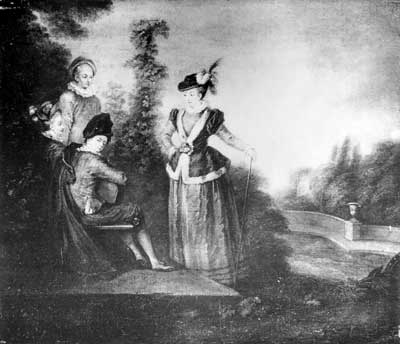
Whereabouts unknown
Oil on canvas
45 x 50 cm
PROVENANCE
Paris, collection of Henry Michel-Lévy (1844-1914; artist). His sale, Paris, May 12-13, 1919, lot 31: “WATTEAU (Attribué à JEAN-ANTOINE.) . . . L’Aventurière. Une jeune femme en robe rose, manteau de couleur lie de vin bordé de fourrure blanche, une fraise autour du cou, est debout dans un parc, la main droite appuyée sur la hanche, l’autre main sur une canne. Elle écoute la sérénade d’un mezzetin vêtu de brun, en manteau bleu, assis sur un banc et pinçant du luth. Près du mezzetin, une femme aux cheveux poudrés et un homme debout en costume de Gilles. A droite, un bassin bordé d’une margelle en pierre ornée d’un vase sur un socle. Toile. Haut., 45 cent.; larg., 50 cent. La même composition a été gravé par Audran, d’après un tableau de moindres dimensions qui se trouve au musée de Troyes et présente d’importantes variantes.”
REMARKS
This is a relatively direct copy of Watteau’s composition, yet there are some differences. The adventuress’ face is no longer in pure profile but is set in a softer, three-quarters view. Also, the figures standing against the wall in the background have been omitted. As best we can judge, some of the colors were changed: the guitarist in the Michel-Levy version has a blue rather than a red mantle.
L’Avanturière (copy 4)
Entered November 2015; revised September 2016
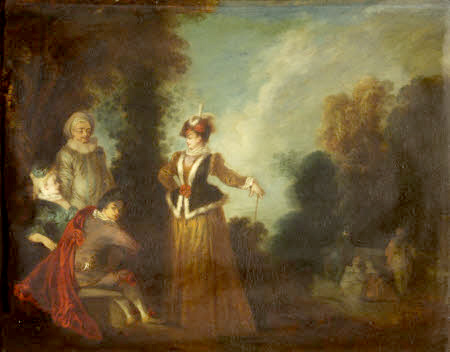
Tyntesfield, North Somerset, National Trust inv. 32573
Oil on panel
31.8 x 40.6 cm
PROVENANCE
Tyntesfield, collection of George Richard Lawley Gibbs (1928-2001; 2nd Baron Wraxall).
Purchased from his estate with the assistance of the National Heritage Memorial Fund, the National Art Collections Fund and donations from members and supporters, 2002.
REMARKS
The copyist responsible for this work was not particularly gifted. On the other hand, the picture is of interest because it seems to have been executed in the eighteenth century and was based directly on Watteau’s original. It not only corresponds in direction to Watteau’s composition but also echoes Watteau’s choice of colors.
L’Avanturière (copy 5)
Entered November 2015; revised September 2016
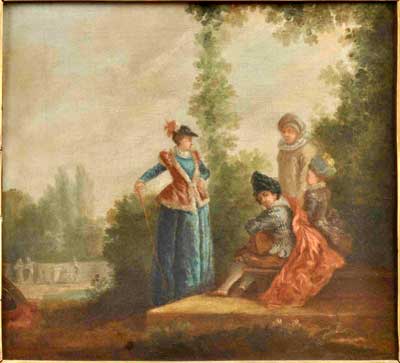
Chartres, Musée des beaux-arts, inv. 5609.
Oil on canvas
35.5 x 38 cm
PROVENANCE
Chartres, collection of Justin Courtois. Donated to the Musée municipal, Chartres, in 1868.
SELECT BIBLIOGRAPHY
Chartres, Musée municipal, Catalogue (1931), cat. 245.
REMARKS
This mediocre copy, apparently based on the Audran engraving, appears to be nineteenth-century in origin.
L’Avanturière (copy 6)
Entered November 2015

Bailleul (Nord), Musée Benoît-de-Puydt
Materials unknown
Measurements unknown
PROVENANCE
This copy of L’Avanturière entered the museum’s collection in 1893.
SELECT BIBLIOGRAPHY
Adhémar, Watteau (1950), under cat. 124.
Washington, Paris, Berlin, Watteau 1684-1721 (1984), under cat. P18.
REMARKS
In 1984, Rosenberg referred to this copy as having once belonged to the Bailleul museum, implying that it is no longer there.
L’Avanturière (copy 7)
Entered November 2015; revised August 2022
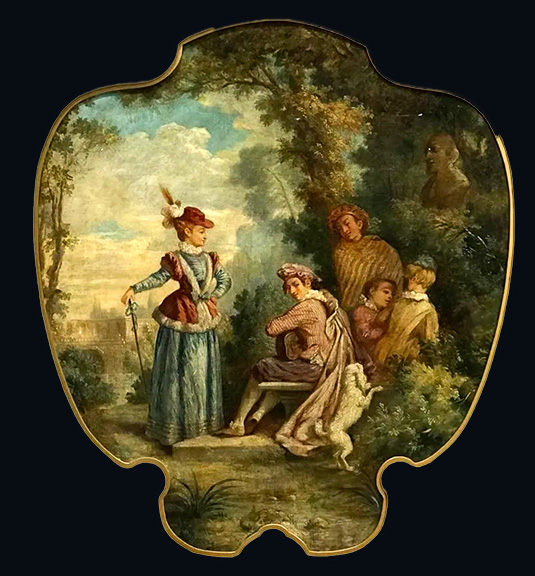
Whereabouts unknown
Materials unknown
139.5 x 128.5 cm
PROVENANCE
New York, Christie’s, February 24-25, 2015, lot 326: “A PAIR OF LOUIS XV STYLE SHIELD-SHAPED OVER DOOR PANELS IN GILTWOOD FRAMES, AFTER FRANCOIS BOUCHER, together with a similar example / The pair 155in. (139.5cm.) high, 50 ½in. (128.5cm.) wide. Est. $3,000 - $5,000.” Sold for $625.
Dallas, Texas, sale, J. Garrett Auctioneers, April 3, 2022, lot 442: Architectural Fragment after Jean Antoine Watteau, The Adventuress, Oil on shaped canvas. Unsigned. Canvas 48 x 39.5 inches. Frame 56 x 50 x 1.5 inches. Est. $100 - $25,000.
Dallas, Texas, J. Garrett Auctioneers, September 11, 2022, lot 592: “Large Oil on Canvas After Jean Antoine Watteau. The Adventuress. Oil on Shaped Canvas. Likely incorporated into Boiserie. Unsigned. Canvas 48 x 39.5 inches. Frame 56 x 50 x 1.5 inches. See Photos For Condition Commensurate With Age. Est $100-$25,000.”
REMARKS
This commercial copy after Watteau, probably made in the nineteenth or twentieth century for the decorator trade, was based upon the Audran engraving.
L’Avanturière (copy 8)
Entered November 2015
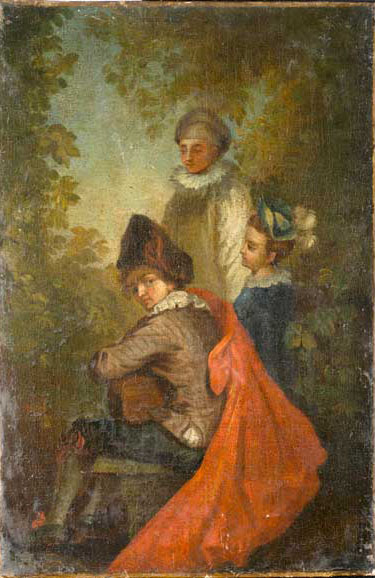
Cracow, collection of Przemyslaw Wiaczkis
Oil on canvas
56 x 38 cm
PROVENANCE
Cracow or its environs, private collection. Sold to Mr. Wiaczkis by the previous owner.
REMARKS
This partial copy of L’Avanturière was based on the Audran engraving after Watteau’s composition.
L’Avanturière (copy 9)
Entered April 2016; revised September 2016
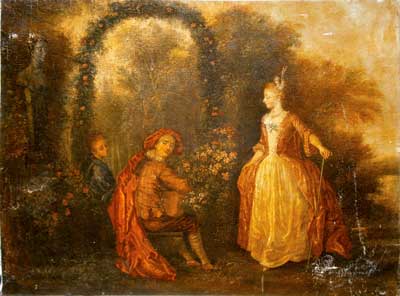
Melbourne, Australia, collection of Stewart Dear
Oil on canvas
60 x 47 cm
REMARKS
This painting is three times larger than Watteau’s, and is much more decorative in its intent. The woman’s distinctive costume has been changed into a later, more ordinary eighteenth-century gown. Watteau’s vague foliage behind the principal figures has been transformed into an elaborate arbor, and there is an overall profusion of leaves and flowers. Much of the right third of Watteau’s composition has been eliminated so as to emphasize the principal figures.
Judging by the poor execution, this painting would seem to be a later century’s response to the French Rococo.
L’Avanturière (copy 10)
Entered March 2017
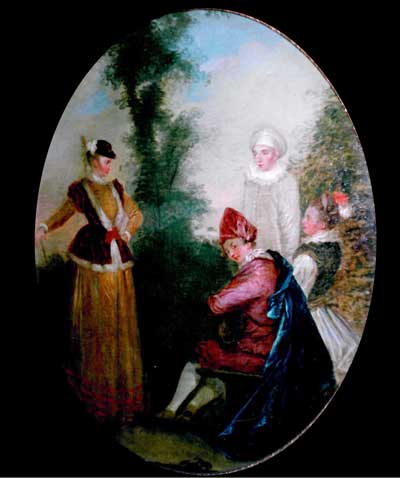
Woodbury, NY, collection of Dr. Stephen and Mrs. Florence Bates
Oil on canvas
28 x 31 in
ALTERNATIVE TITLES
The Hiring of Actors
PROVENANCE
New York art market, c. 1967
REMARKS
Although the painting was formerly attributed to Watteau, it clearly is just a poor modern copy after the Audran engraving. The original horizontal composition was compressed into a vertical one, and tailored to an oval format.
L’Avanturière (copy 11)
Entered July 2018

Whereabouts unknown
Materials unknown
Measurments unknown
PROVENANCE
London, with D'Amour. This information comes from the annotated copy of the sale catalogue from the auction house, now in the National Art Library, Victoria and Albert Museum
London, sale, Foster and Son, May 9, 1849, lot 53: “Watteau . . . . L’Avanturiére.” Sold for 13 guineas to Longmore. The price and buyer’s name are recorded in the annotated copy of the sale catalogue from the auction house, now in the National Art Library, Victoria and Albert Museum.
L’Avanturière (copy 12)
Entered August 2020; revised April 2021
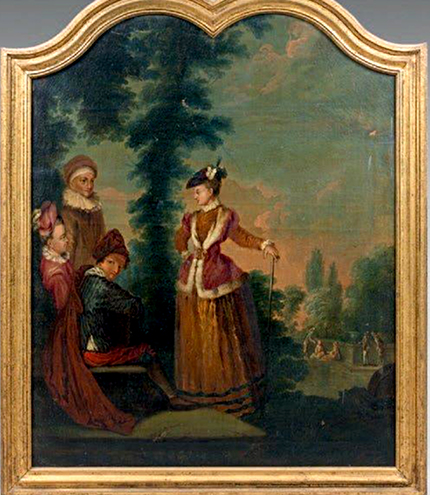
Whereabouts unknown
Oil on canvas
Measurements unknown
PROVENANCE
Paris, sale, Hôtel Drouot (Mathias-Baron Ribeyre), October 22, 2014, lot 16: "École FRANÇAISE du XVIIIe siècle / d’après Antoine WATTEAU / Réunion galante / Toile à haut chantourné. R.M. 1 000 €."
REMARKS
Constrained to a shaped space, Watteau’s composition has been fitted to these new demands. But whether this was done in the eighteenth century or the nineteenth is moot.
L’Avanturière (copy 9)
Entered April 2016; revised September 2016

Melbourne, Australia, collection of Stewart Dear
Oil on canvas
60 x 47 cm
REMARKS
This painting is three times larger than Watteau’s, and is much more decorative in its intent. The woman’s distinctive costume has been changed into a later, more ordinary eighteenth-century gown. Watteau’s vague foliage behind the principal figures has been transformed into an elaborate arbor, and there is an overall profusion of leaves and flowers. Much of the right third of Watteau’s composition has been eliminated so as to emphasize the principal figures.
Judging by the poor execution, this painting would seem to be a later century’s response to the French Rococo.
L’Avanturière (copy 13)
Entered June 2021
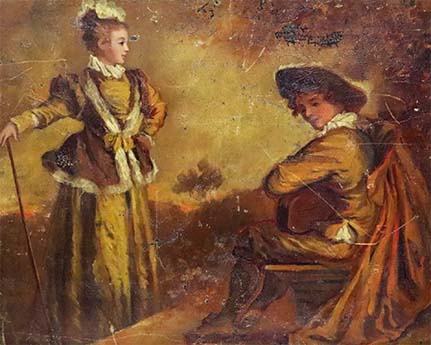
Whereabouts unknown
Oil on panel
34 x 42 cm
ALTERNATIVE TITLES
Musicien et élégante
PROVENANCE
Nevers, sale, Metayer Maison de ventes aux enchères, January 31, 2021, lot 591: “Nicolas LANCRET. . . suiveur de. Musicien et élegante. Huile sur panneau. H_34 cm L_42 cm, griffures. Est. 100-150 €.”
REMARKS
Wrongly attributed to a follower of Lancret, this painting is a crude copy of Audran’s print after Watteau’s L’Avanturière.
L’Avanturière (copy 14)
Entered June 2021
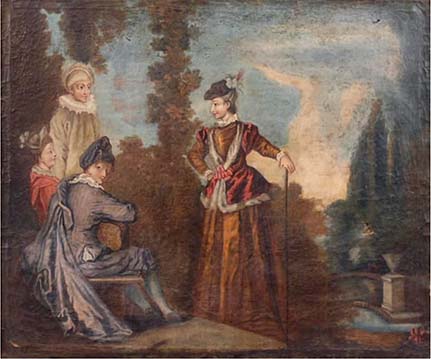
Whereabouts unknown
Oil on canvas
62 x 74 cm
ALTERNATIVE TITLES
La Promenade
PROVENANCE
Paris, private collection. Sale, Paris, Ferri ventes aux enchères, October 30, 2013, lot 20: “École FRANÇAISE de la fin du XVIIIe siècle. La Promenade d’après Watteau Huiler sur toile, rentoilée Haut. 62 – Larg. 74 cm. est. 800 -1200 EUR.” Sold for €450.
REMARKS
This maladroit painting follows the direction of the original Watteau painting in Troyes, but it is at a far remove in terms of quality. Whether it proves to be provincial or amateur work, it seems doubtful that it can be dated with any certainty to the eighteenth century.
L’Avanturière (copy 15)
Entered August 2021
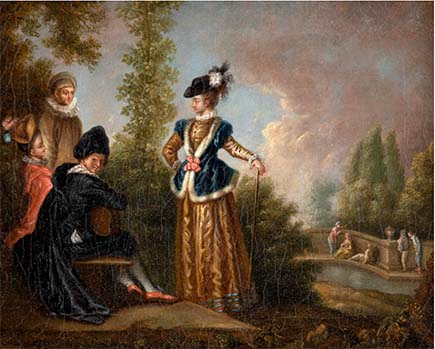
Whereabouts unknown
Oil on canvas
28 x 35 cm
ALTERNATIVE TITLES
Pierrot Playing the Guitar in the Presence of Two Young Ladies
PROVENANCE
Rhineland, private collection.
Düsseldorf, sale, Hargesheimer Kunstauktionen Düsseldorf, September 11, 2021, lot 2743: “ANTOINE WATTEAU (WORKSHOP) . . . PIERROT PLAYING THE GUITAR IN THE PRESENCE OF TWO YOUNG LADYS Oil on canvas (old relined). 28 x 35 cm (F. 40 x 47 cm). Verso: Indistinctly inscribed on the stretcher on an old paper label in old writing. Part. min. old restored. Frame. Provenance: Rhenish Private Collection.” Est. €3,300-6,600.
REMARKS
As the direction of this painting shows, this copy follows Watteau’s composition rather than Audran’s print, but its very poor quality of execution removes it from Watteau’s workshop. Is it even French or eighteenth century in origin?
L’Avanturière (copy 16)
Entered August 2021

Whereabouts unknown
Materials unknown
Measurements unknown
ALTERNATIVE TITLES
A Music Party, in the Gardens of a Château
PROVENANCE
London, sale, Christie and Manson, April 2, 1852, lot 32: “Watteau . . . “A music party, in the gardens of a château.”
REMARKS
The collection sold in 1852 was said to be that of “an amateur” and that it had been “formed during a Residence on the Continent.” It included not only this copy of L’Avanturière but also one after L’Enchanteur (our copy 8) which was offered in the previous lot: “A cavalier, playing the guitar to two ladies seated in a garden.” Indeed, were it not for the more explicit description of the previous lot, we would not have been able identify this one.
Were these pendants ones that we know today? They cannot be the ones in Brodick Castle (copy 1) because those were already with the Beckford family before 1852.
For L'Avanturière CLICK HERE